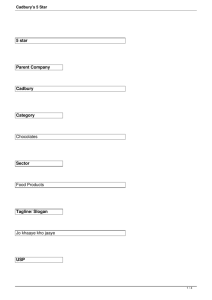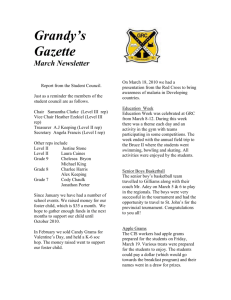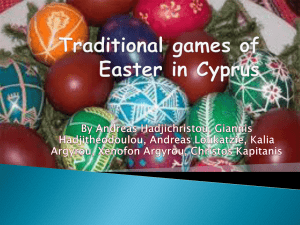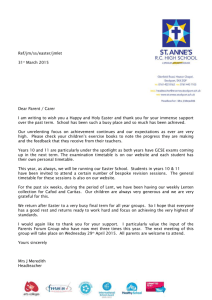Case study 51 | Operations processes at the Cadbury's factory for
advertisement
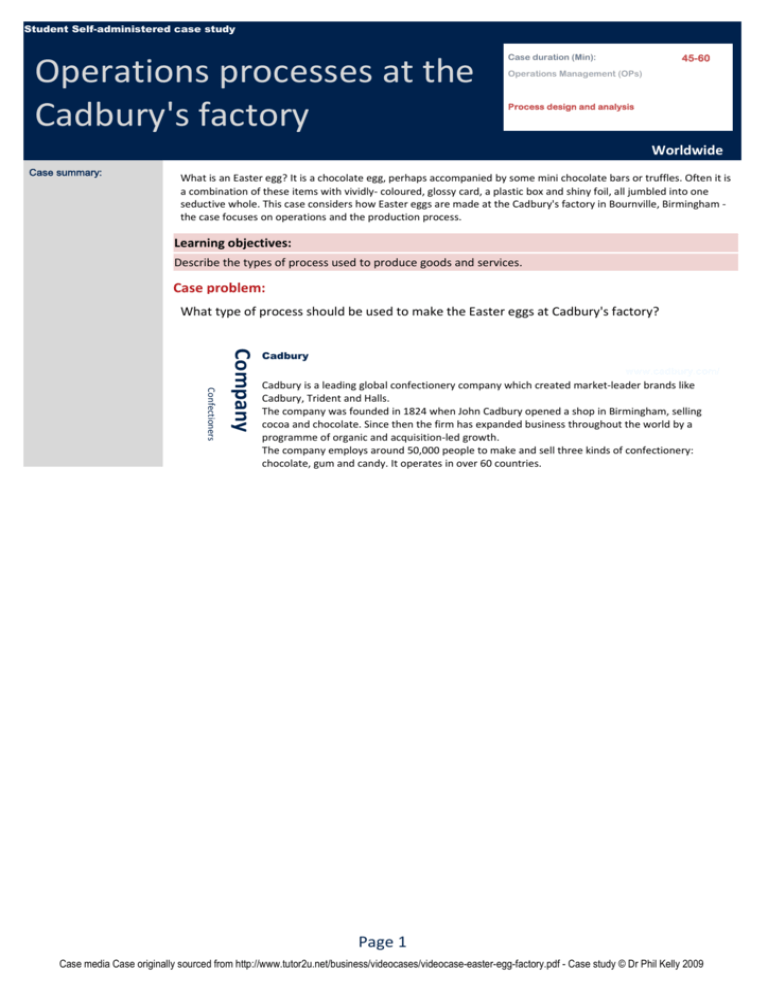
Student Self-administered case study Operations processes at the Cadbury's factory 45-60 Case duration (Min): Operations Management (OPs) Process design and analysis Worldwide Case summary: What is an Easter egg? It is a chocolate egg, perhaps accompanied by some mini chocolate bars or truffles. Often it is a combination of these items with vividly‐ coloured, glossy card, a plastic box and shiny foil, all jumbled into one seductive whole. This case considers how Easter eggs are made at the Cadbury's factory in Bournville, Birmingham ‐ the case focuses on operations and the production process. Learning objectives: Describe the types of process used to produce goods and services. Case problem: What type of process should be used to make the Easter eggs at Cadbury's factory? Confectioners Company Cadbury www.cadbury.com/ Cadbury is a leading global confectionery company which created market‐leader brands like Cadbury, Trident and Halls. The company was founded in 1824 when John Cadbury opened a shop in Birmingham, selling cocoa and chocolate. Since then the firm has expanded business throughout the world by a programme of organic and acquisition‐led growth. The company employs around 50,000 people to make and sell three kinds of confectionery: chocolate, gum and candy. It operates in over 60 countries. Page 1 Case media Case originally sourced from http://www.tutor2u.net/business/videocases/videocase-easter-egg-factory.pdf - Case study © Dr Phil Kelly 2009 First, if you are taking a taught management course then consult with your tutor and ensure that the case has not been scheduled into a teaching class or tutorial. If it has not: 1. Play/ read the media associated with the case. You may need to access the Internet and enter a URL to locate any video clips. 2. Attempt the Case study questions. Consider attempting the case study as a group exercise; you could form a study group with fellow students. 3. Check the suggested answers - remember these are suggestions only and there are often many possible answers. Discuss questions and answers with other students. 4. If you feel your answer(s) were weak then consider reading the relevant suggested readings again (also see the case study suggested references). Title/ Media type How do you make 40m Easter eggs? Film URL/ Media description http://news.bbc.co.uk/1/hi/uk/7990080.stm How they make the Easter eggs at the Cadbury's factory in Bournville, Birmingham. Inside a frozen pizza factory. Film http://news.bbc.co.uk/1/hi/business/7733602.stm Product development manager Ciara Morgan gives a tour around the Goodfella's pizza site in Naas. NOTES: Page 2 Case media Case originally sourced from http://www.tutor2u.net/business/videocases/videocase-easter-egg-factory.pdf - Case study © Dr Phil Kelly 2009 Case study questions... Pre/During/After class Action 1 TRANSFORMATION PROCESS MODEL : During With reference to the TRANSFORMATION PROCESS MODEL, analyse and describe how Easter eggs are made at the Cadbury's factory in Bournville, Birmingham. In your answer you should identify the inputs/ raw materials and the transformational resources used within the process. 2 DEFINE : 3 PROCESS : 4 PRODUCTIVITY : 5 PACKAGING : During DEFINE the following terms – operations, production, production line. During Categorise and describe the PROCESS used to make Easter eggs at Cadburys. During With reference to efficiency, resource utilisation and waste, discuss PRODUCTIVITY and process analysis for improvement at Cadburys. During For several years various MPs have campaigned against excess packaging on Easter eggs. In addition, there are voices from the environmental lobby that single out the Easter egg as quite the most outrageous piece of over-packaging in the realm of retail; as a consequence, some manufacturers have been named and shamed for their over-packaged eggs. On the other hand there are consumers whose eye needs to be drawn to products that make them feel like they want to give them as a gift. Critically review, with reference to environmentally friendly and corporate social responsibility goals, the use of Easter egg PACKAGING. Consider the options facing manufacturers. Page 3 Case media Case originally sourced from http://www.tutor2u.net/business/videocases/videocase-easter-egg-factory.pdf - Case study © Dr Phil Kelly 2009 Answers... OPERATIONS The core activities of a business PRODUCTION Activities involved in creating a product PRODUCTION LINE a set of sequential operations established in a factory whereby materials are transformed to produce an end‐ product or components are assembled to make a finished article PRODUCTION RUN completion of all tasks is associated with a production order PRODUCTIVITY an economic measure of efficiency that summarises the value of outputs relative to the value of inputs used to create them CONTINUOUS FLOW PROCESS A type of manufacturing process that closely resembles a production line process. The main difference is the form of the product, which usu‐ally cannot be broken into discrete units. Examples include yarns and fabric, food products, and chemical products such as oil or gas. PACKAGING Question/ Answer 1 TRANSFORMATION PROCESS MODEL : With reference to the TRANSFORMATION PROCESS MODEL, analyse and describe how Easter eggs are made at the Cadbury's factory in Bournville, Birmingham. In your answer you should identify the inputs/ raw materials and the transformational resources used within the process. Transformation process model - model that describes operations in terms of their input resources, transforming processes and outputs of goods and services. Inputs: molten chocolate, packaging (foil, tray, carton). Transformational resources used: Moulds, robotics, factory, machinery (line etc), knowledge, people, information systems. The eggs are made in the following stages: (1) deposit molten chocolate into the half mould shell, tip upside down to remove excess chocolate for recycling; (2) remove eggs from the mould; (3) join halves and wrap in foil; (4) place eggs and extras into tray, then carton. 2 DEFINE : DEFINE the following terms – operations, production, production line. Operations - The core activities of a business. Production - Activities involved in creating a product. Production line - a set of sequential operations established in a factory whereby materials are transformed in order to produce an end-product or components are assembled to make a finished article. 3 PROCESS : Categorise and describe the PROCESS used to make Easter eggs at Cadburys. Students should recognise that this is NOT a project or job shop process but a flow (continuous). The product is standard and produced in high volumes, made to stock, in a fixed processing sequence. Significant investment in the factory facilities and equipment is required and the movement of goods between process steps is automated. This is essentially a 24/7 continuous operation with limited human resource involvement. HR required skills are low. 4 PRODUCTIVITY : With reference to efficiency, resource utilisation and waste, discuss PRODUCTIVITY and process analysis for improvement at Cadburys. Productivity - an economic measure of efficiency that summarises the value of outputs relative to the value of inputs used to create them. Students should recognise that efficiency is likely to lead to increased revenues by reducing costs. Reducing waste (the excess chocolate from stage 1 is recycled) reduces cost and may improve quality and social responsibility attainment. Costs are also reduced through automation, technology and robotics. The transforming resources and process also decrease flow time. 5 PACKAGING : From a logistics perspective, the way goods and materials are packed in order to facilitate physical, informational, and monetary flows through the supply chain. TRANSFORMING RESOURCES For several years various MPs have campaigned against excess packaging on Easter eggs. In addition, there are voices from the environmental lobby that single out the Easter egg as quite the most outrageous piece of over‐packaging in the realm of retail; as a consequence, some manufacturers have been named and shamed for their over‐packaged eggs. On the other hand there are consumers whose eye needs to be drawn to products that make them feel like they want to give them as a gift. Critically review, with reference to environmentally friendly and corporate social responsibility goals, the use of Easter egg PACKAGING. Consider the options facing manufacturers. the resources that act upon the transformed resources, usually classified as facilities (the buildings, equipment and plant of an operation) and staff (the people who operate, maintain and manage the operation). Adds value through enhancing the customer experience (pleasure of opening egg) but creates excessive rubbish. Packaging - From a logistics perspective, the way goods and materials are packed in order to facilitate physical, informational, and monetary flows through the supply chain. Nestle has eliminated many of the plastic inserts (used to hold the egg in place and protect it) from its boxes and reduced the amount of cardboard used. Mars is using print ads to trumpet its reduced packaging, and Cadbury's are shrinking boxes, having also introduced their Treasure Eggs range which do not come in a box. Page 4 Case media Case originally sourced from http://www.tutor2u.net/business/videocases/videocase-easter-egg-factory.pdf - Case study © Dr Phil Kelly 2009 INPUT. The input to a system can be thought of as the raw materials for a process that will produce a particular output. Examples of inputs might include data, knowledge, raw materials, machinery and premises. TRANSFORMATION PROCESS MODEL model that describes operations in terms of their input resources, transforming processes and outputs of goods and services. Case study references Cole, G A. and Kelly, P P. (2011) 'Management Theory and Practice', Ed. 7. Cengage EMEA. Collier, D. and Evans, J. (2009) 'OM', Ed. 1. Cengage Learning. Evans, J. and Collier, D. (2007) 'Operations Management Integrated Goods & Services Approach, International Edition', Ed. 2. South Western. Kelly, P P. (2009) 'International Business and Management', Cengage Learning EMEA. Page 5 Case media Case originally sourced from http://www.tutor2u.net/business/videocases/videocase-easter-egg-factory.pdf - Case study © Dr Phil Kelly 2009



